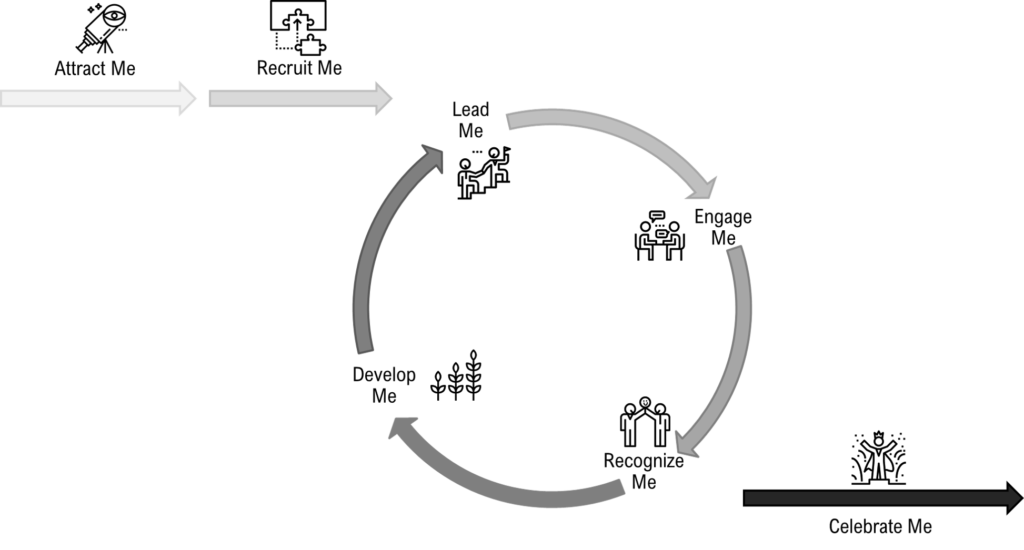We’ve talked a lot these past weeks about the first two stages of the Employee Lifecycle – Attract Me and Recruit Me. From posting on social media to being purpose-driven, we have shared stories and strategies for generating interest in your organization. But why does that promising candidate struggle once they are an employee? How can you set them, and you, up for success? The following is a cautionary tale from one of our clients, *Paul, a Marketing executive.
My first job was with a consulting firm for their top sales Manager. I was thrown into the deep end with little training, long hours, and lots of traveling. BUT I LOVED IT. I also had, what I believed, was a great mentor and role model in *John. I quickly stretched my skills and racked up certifications in Project Management and Leadership. My performance reviews were above-average. I was told I was on track for a promotion. But it didn’t happen. There was always a reason; no budget, no suitable roles… Then, after my fourth year of 3-4% raises and token bonuses, something happened. A colleague widely known as a low-performer was promoted into a role that was right for me. I wasn’t even given the chance to apply. When I asked John about it he said that I was “the most qualified.” He also said she got it because she was with the company longer. “That is just the way it works around here. I’m sorry” he said. When I gave my notice a few weeks later he stopped talking to me. Most of the team avoided me. It was like my entire time at the company, all of our accomplishments, meant nothing.”
This story is not unique. It’s also not that bad. Paul clearly got a lot out of it. But as career coaches, we hear variations of it all the time. Disillusioned employees who were wooed at the start. Continuously led to believe they are exceptional with words. But then, nothing. So let’s look back to Paul’s story, through the lens of his employee lifecycle, for improvement cues.
Lead Me
Employees leave poor leaders. But those poor leaders don’t manifest on their own. Not for the most part anyway. Your organization’s culture has tremendous sway over how your managers show up – or don’t – as leaders. Every day you send signals about what is rewarded, tolerated, or punished. Now if you have one or two bad eggs, address it. If your leaders are doing a poor job in mass you can only look inward, and upward.
Paul was clear about his desire to move up. John knew that it was not possible. He still led Paul to believe that it was. I know some of you are thinking that as an officer of the company John was doing the right thing. Consider that there is another way. He could have been honest. He could have worked with Paul on a plan that would suit them both.
Paul may have worked as hard, though maybe not for as long, if John was transparent. Perhaps being provided the same development opportunities, and an agreement for support when it was time to go, would have suited Paul. We will never know. Instead, John misled Paul and lost his trust. Trust is the cornerstone of a true leader. It requires a leader to be honest about opportunities, and limitations, and align rewards accordingly throughout the Employee Lifecycle. Because John was thinking narrowly, maybe putting his own needs first, Paul felt marginalized. What could have been an enduring professional relationship is instead a bitter footnote in Paul’s career.
Engage Me
Paul was engaged. Unfortunately, similar to his manager’s lack of leadership, the company fell short. “Not surprising.” he said, “their annual survey scores are in a state of perpetual decline, everything is artificial. If you stayed long enough you can see things repeat. In spite of Culture surveys, training, focus groups… no clear change outside of the constant reorganizations that kept us in fear.”
Now we know some of you are rolling eyes when we mention engagement and culture. And we recognize that reorganizations have very valid applications. But hear us out, for your bottom line. In a case study with Gallop one multinational retail company reports it generated an estimated $82 million in profit growth over four years. This is attributed to improvements in employee engagement. The CliffsNotes Spoiler: “Those managers who were able to separate “flavor of the month” company initiatives from more important, long-term objectives, such as employee and customer engagement, had measurably superior employee engagement.”
Develop & Recognize Me
We group the employee lifecycle stages of development and recognition in this discussion. This is because they are interdependent. It is necessary, for the sake of your employees and your business strategy, to ensure that how you develop and incentivize your people is aligned, consistent, and flexible enough to personalize. Paul felt rewarded at the start by the development opportunities. But he talks about his salary and bonus with disdain. He goes on to describe how seeing a low-performer rewarded for ‘time-served’ was a clear signal to leave. A strong talent management strategy could have resulted in a very different ending. Take the approach of the Boulder-based content marketing company Kapost;
Exit Me
This is the stage where Paul’s organization failed. Miserably, as many companies do. They treated him like he didn’t exist. This is short-term thinking. Voluntary exits are your best resources for referring great talent. They know how your organization works.
To sum up…
Your organization has opportunities all along an employee’s time with you, and beyond, to make a good impression. Consider:
- Ask each team member about their career goals and support their development.
- Having regular Talent Reviews with leaders across the organization. Promote high-performers for opportunities that will help them reach their goals – even if it means you lose them.
- Reward ONLY the behaviors you say you value. Make it beneficial for employees to adopt them.
- Pay for Performance. Don’t entice candidates with a big salary or sign-on bonus, only to award nominal increases annually.
- Celebrate employees when they leave. If they are going voluntarily they clearly contributed to your success. Show them that means something.
As you can see from our header graphic, at The Hire we adopt a slightly different view of the traditional employee lifecycle from our partners at Engagethem. Stay tuned over the coming weeks for more information about it, and how you can engage your employees at every touch point. Next week is “Lead Me” – leaders develop leaders.
*Names and occupations changed for anonymity of our clients


